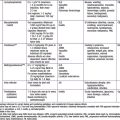Chapter 483 Abnormalities of Lymphatic Vessels
Abnormalities of the lymph vessels may be congenital or acquired. Signs and symptoms result from increased lymphatic tissue mass or from leakage of lymph. Lymphangiectasia is dilation of the lymphatics. Pulmonary lymphangiectasia causes respiratory distress (Chapter 387.6). Involvement of the intestinal lymphatics causes hypoproteinemia and lymphocytopenia secondary to loss of lymph into the intestines (Chapter 330). Therapy includes minimizing the hydrostatic pressure in the lymphatic system, leading to decreased protein loss. Reducing dietary intake of long chain fatty acids and substituting medium chain triglycerides via formula accomplishes this goal. Lymphangioma is a congenital lymphatic malformation, usually detected by the age of 2 yr. Lymphangioma circumscriptum is defined as the presence of many small, superficial lymphangiomas. Deeper lymphangiomas are classified as either cavernous lymphangiomas or cystic hygromas. Lymphangiomatosis is the presence of multiple or disseminated malformations. Some of these lesions also have a hemangiomatous component (Chapter 499). Emergent surgical treatment is infrequently necessary due to mass effects. Most lesions may be observed for 18-24 mo to assess for involution. Surgery is effective for superficial lesions, but is complicated by a high incidence of recurrence when used for deeper lesions. Intralesional sclerosing with a streptococcal derivative called OK-432 has been used successfully in selected patients. Other sclerotherapy agents include pure ethanol and bleomycin. Macrocystic lesions appear to respond better than microcystic lymphangiomas to sclerotherapy. Radiofrequency ablation has been used for lymphatic lesions of the tongue. Lymphatic dysplasia may cause multisystem problems, including lymphedema, chylous ascites, chylothorax, and lymphangiomas of the bone, lung, or other sites.
Alitalo K, Tammela T, Petrova TV. Lymphangiogenesis in development and human disease. Nature. 2005;438:946-953.
Bloom DC, Perkins JA, Manning SC. Management of lymphatic malformations. Curr Opin Otolaryngol Head Neck Surg. 2004;12:500-504.
Cueni LN, Detmar M. The lymphatic system in health and disease. Lymphat Res Biol. 2008;6:109-122.
Fischer P, Supali T, Maizels RM. Lymphatic filariasis and Brugia timori: prospects for elimination. Trends Parasitol. 2004;20:351-355.
Nakamura K, Rockson SG. Molecular targets for therapeutic lymphangiogenesis in lymphatic dysfunction and disease. Lymphat Res Biol. 2008;6:181-189.
Radhakrishnan K, Rockson SG. The clinical spectrum of lymphatic disease. Ann N Y Acad Sci. 2008;1131:155-184.




